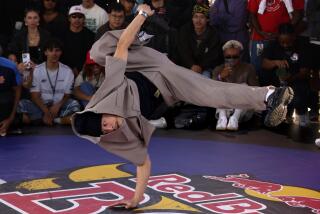The Venus of Muscle Beach
- Share via
Decades before Linda Hamilton muscled up for “Terminator 2,” Pudgy Stockton was developing better biceps than most men. She was supporting her husband, Les--not financially, but in high hands-to-hands and other gymnastic maneuvers learned at a place called Muscle Beach.
Now Pudgy, 80, and Les, 81, live in a Santa Monica apartment less than a mile from the site of the original Muscle Beach (closed in 1959). Their two-bedroom apartment overflows with photographs and mementos carefully catalogued by Pudgy; they tell the history of ground zero for the fitness revolution.
Unlike the frivolous scene promoted in movies such as 1964’s “Muscle Beach Party,” with Frankie Avalon and Annette Funicello, talented athletes of all ages gathered at Muscle Beach in enthusiastic exhibitions of a pastime that was more acrobatics than bodybuilding as it’s known today.
Acrobats were popular nightclub entertainers in the ‘30s, while bodybuilding and weight training were considered freakish, even dangerous. Mail-order isometric fitness hawker Charles Atlas discouraged weight training as bad for the heart. “Experts” warned that men would become “muscle-bound,” and women would become (gasp!) like men. Colleges kept what crude weight equipment they had under lock and key, accessible only to football players and wrestlers.
Nevertheless, fans of “physical culture” began gathering at Santa Monica Beach just south of the pier toward the end of the Depression. Volleyball and other games soon led to gymnastics and weightlifting demonstrations on equipment that had been installed as part of a WPA program. Abbye Eville, a 19-year-old telephone operator who went by the childhood nickname of Pudgy, joined in at the urging of her then-boyfriend, Les Stockton. Abbye had gained a few pounds since starting work as an operator for the telephone company upon graduation from Santa Monica High School.
“I started trying calisthenics from magazines and the few books I could find at the library,” says Pudgy. “Then Les brought over some light weights, mostly dumbbells. I was skeptical, but soon I branched out into a wide variety of exercises.”
Pudgy quickly became a star of the Muscle Beach scene. She admits, reluctantly, to many admiring stares and whistles from men when she was on the beach. Les insists he never minded being “Mr. Pudgy,” as his curvaceous mate attracted fans and photographers. After all, he’d helped transform her into a 5-foot-1 blond Venus.
Adding to Pudgy’s exotic quality were the two-piece bathing suits she wore. “In those days, you couldn’t buy a two-piece bathing suit,” Pudgy says. “So my mother ripped apart an old brassiere of mine, and made a pattern from that.”
Soon, Pudgy was having the suits custom-tailored. Modest by today’s standards, they were one reason she ended up in magazines around the world, and not only those catering to the muscle crowd. One weekly news magazine--the American Weekly of the L.A. Examiner--ran photos of Pudgy sewing and washing dishes at home, alongside photos of her lifting weights at Muscle Beach, to prove she was still ladylike.
As Les and other Muscle Beach participants were called into service in World War II, the scene there temporarily died down.
Pudgy and Les married in 1941, and she followed him to Victorville, where he was stationed with the Army Air Corps and she did office work. After the war, returning servicemen took Muscle Beach more seriously than ever. Like many of their colleagues (including Vic Tanny and Joe Gold), Les and Pudgy opened bodybuilding gyms: Pudgy’s women’s gym, the quaintly named Salon of Figure Development, opened in 1948 on Sunset near Alvarado. Two years later, the couple opened men’s and women’s gyms, called the Stockton Studios, next to each other on Pico Boulevard in Beverly Hills. They moved them to Pasadena in 1952.
Pudgy’s was perhaps the first women’s bodybuilding gym in the country, though she was careful to advertise it as a place to “reduce” rather than bulk up. She often put in 12-hour days, training women in a living room-like setting filled largely with custom-made equipment. Instead of mirrors and chrome, Pudgy’s gym strived for a cozy atmosphere to put women at ease. The walls were paneled and wallpapered; workout benches were made to look more like furniture than the stripped-down instruments they are today.
Pudgy quit the gym business in 1955 to stay home with her only child, Laura Jeanne, who now lives in Washington state and is an avid outdoorswoman. Pudgy and Les curtailed their Muscle Beach activity to weekend visits, when, by the late ‘50s, thousands were coming to watch acrobats and weightlifters on sunny Saturday afternoons.
It didn’t last. The City of Santa Monica--then a quiet, conservative community--closed down Muscle Beach in 1959, claiming it was attracting the “wrong element.” Two men who worked out there--but were not regulars, Les and Pudgy insist--were accused, though never convicted, of statutory rape.
The Muscle Beach crowd gravitated south toward “The Pit” in Venice, a hangout for hard-core weightlifters and bodybuilders. The scene there was almost exclusively male. Steroids soon became commonplace, and bodybuilders took on cartoonishly large proportions.
This fall, the City of Santa Monica plans to expand the recreation equipment available at the original Muscle Beach site as part of its overhaul of the area around the pier. A site for fitness for toddlers is planned alongside the parallel bars and rings already there. Only a small plaque erected in 1989 marks the location of the original Muscle Beach.
Today, Les and Pudgy exercise mainly by walking, climbing the 6th Street steps, working with light weights and doing mat work at home. Pudgy still uses 10-pound dumbbells and a 40-pound bar. And the results of their efforts at Muscle Beach live on, in a modern aesthetic that favors muscled bodies for men and women.
The Stocktons aren’t quick to condemn steroid use, a big part of competitive bodybuilding today. “Oh, if we’d had steroids, we would’ve taken them,” says Les. Pudgy isn’t so sure, but says, “It’s a different era. Women have contests just like the men do . . . and in my day, some people accused me of going too far with bodybuilding.”


